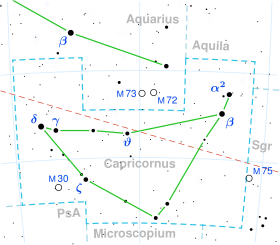
Summary
Omicron Capricorni (ο Capricorni) is a wide binary star[11] system in the constellation Capricornus.[12] The brighter component has an apparent visual magnitude of +5.94,[2] which is near the lower limit on stellar brightness that still can be seen with the naked eye. Based upon an annual parallax shift of 15.07 mas as seen from Earth,[1] this system is located roughly 220 light-years from the Sun. Large but uncertain discrepancies in the parallax measurements from Hipparcos may indicate, weakly, that there is a third, unseen companion in the system.[11]
| Observation data Epoch J2000.0 Equinox J2000.0 (ICRS) | |
|---|---|
| Constellation | Capricornus |
| ο Cap A | |
| Right ascension | 20h 29m 53.91117s[1] |
| Declination | −18° 34′ 59.4803″[1] |
| Apparent magnitude (V) | +5.94[2] |
| ο Cap B | |
| Right ascension | 20h 29m 52.59487s[1] |
| Declination | −18° 35′ 10.7447″[1] |
| Apparent magnitude (V) | +6.74[2] |
| Characteristics | |
| ο Cap A | |
| Spectral type | A1 V[3] |
| U−B color index | +0.30[2] |
| B−V color index | +0.08[2] |
| ο Cap B | |
| Spectral type | A7/8 V[3] |
| U−B color index | +0.04[2] |
| B−V color index | +0.22[2] |
| Astrometry | |
| ο Cap A | |
| Radial velocity (Rv) | −12.4±1.3[4] km/s |
| Proper motion (μ) | RA: +31.70[1] mas/yr Dec.: −83.18[1] mas/yr |
| Parallax (π) | 15.07 ± 4.14 mas[1] |
| Distance | approx. 220 ly (approx. 70 pc) |
| ο Cap B | |
| Radial velocity (Rv) | −9.1±0.6[4] km/s |
| Proper motion (μ) | RA: +33.31[1] mas/yr Dec.: −66.16[1] mas/yr |
| Details | |
| ο Cap A | |
| Mass | 2.05±0.20[5] M☉ |
| Luminosity | 18.6[5] L☉ |
| Surface gravity (log g) | 4.23[6] cgs |
| Temperature | 10,492±357[6] K |
| Rotational velocity (v sin i) | 276[7] km/s |
| Age | 118[6] Myr |
| ο Cap B | |
| Mass | 1.34±0.24[5] M☉ |
| Temperature | 7,762[5] K |
| Rotational velocity (v sin i) | 136[7] km/s |
| Other designations | |
| ο Cap A: BD−19° 5831, GC 28503, HD 195094, HIP 101123, HR 7830, SAO 163626[9] | |
| ο Cap B: BD−19° 5830, GC 28502, HD 195093, HIP 101120, HR 7829, SAO 163625[10] | |
| Database references | |
| SIMBAD | A |
| B | |
Both visible components are white-hued A-type main-sequence stars.[3] The primary, component A, sometimes called ο1 Capricorni, has an apparent magnitude of +5.94, while the companion, component B or ο2 Capricorni, has an apparent magnitude of +6.74.[2] The two stars are currently separated by 21.91[11] arcseconds, corresponding to a projected separation of around 2,100 AU.[13] At the estimated age of around 118[6] million years old, both components are spinning rapidly: component A has a projected rotational velocity of 276 km/s, while component B is 136 km/s.[7]
References edit
- ^ a b c d e f g h i j van Leeuwen, F. (2007), "Validation of the new Hipparcos reduction", Astronomy and Astrophysics, 474 (2): 653–664, arXiv:0708.1752, Bibcode:2007A&A...474..653V, doi:10.1051/0004-6361:20078357, S2CID 18759600.
- ^ a b c d e f g h Johnson, H. L.; et al. (1966), "UBVRIJKL photometry of the bright stars", Communications of the Lunar and Planetary Laboratory, 4 (99): 99, Bibcode:1966CoLPL...4...99J.
- ^ a b c Houk, Nancy; Smith-Moore, M. (1978), Michigan catalogue of two-dimensional spectral types for the HD stars, vol. 4, Ann Arbor: Dept. of Astronomy, University of Michigan, Bibcode:1988mcts.book.....H.
- ^ a b Gontcharov, G. A. (November 2006), "Pulkovo Compilation of Radial Velocities for 35495 Hipparcos stars in a common system", Astronomy Letters, 32 (11): 759–771, arXiv:1606.08053, Bibcode:2006AstL...32..759G, doi:10.1134/S1063773706110065, S2CID 119231169.
- ^ a b c d Zorec, J.; Royer, F. (2012), "Rotational velocities of A-type stars. IV. Evolution of rotational velocities", Astronomy & Astrophysics, 537: A120, arXiv:1201.2052, Bibcode:2012A&A...537A.120Z, doi:10.1051/0004-6361/201117691, S2CID 55586789.
- ^ a b c d David, Trevor J.; Hillenbrand, Lynne A. (2015), "The Ages of Early-Type Stars: Strömgren Photometric Methods Calibrated, Validated, Tested, and Applied to Hosts and Prospective Hosts of Directly Imaged Exoplanets", The Astrophysical Journal, 804 (2): 146, arXiv:1501.03154, Bibcode:2015ApJ...804..146D, doi:10.1088/0004-637X/804/2/146, S2CID 33401607.
- ^ a b c Royer, F.; Zorec, J.; Gómez, A. E. (February 2007), "Rotational velocities of A-type stars. III. Velocity distributions", Astronomy and Astrophysics, 463 (2): 671–682, arXiv:astro-ph/0610785, Bibcode:2007A&A...463..671R, doi:10.1051/0004-6361:20065224, S2CID 18475298.
- ^ "omi Cap". SIMBAD. Centre de données astronomiques de Strasbourg. Retrieved 2017-08-31.
- ^ "omi Cap A". SIMBAD. Centre de données astronomiques de Strasbourg. Retrieved 2017-08-31.
- ^ "omi Cap B". SIMBAD. Centre de données astronomiques de Strasbourg. Retrieved 2017-08-31.
- ^ a b c Eggleton, P. P.; Tokovinin, A. A. (September 2008), "A catalogue of multiplicity among bright stellar systems", Monthly Notices of the Royal Astronomical Society, 389 (2): 869–879, arXiv:0806.2878, Bibcode:2008MNRAS.389..869E, doi:10.1111/j.1365-2966.2008.13596.x, S2CID 14878976.
- ^ Harvard College Observatory (1941). Sky and Telescope. Stanford University.
- ^ Abt, Helmut A. (August 1988), "Maximum Separations among Cataloged Binaries", Astrophysical Journal, 331: 922, Bibcode:1988ApJ...331..922A, doi:10.1086/166609.



